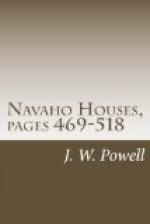As the architecture of a primitive people is influenced largely by the character of the country in which they live, a brief description of the Navaho reservation is deemed necessary. Similarly, the habits of life of the people, what a naturalist would term their life history, which in combination with the physical environment practically dictates their arts, is worthy of notice, for without some knowledge of the conditions under which a people live it is difficult, if not impossible, to obtain an adequate conception of their art products.
The winter hogans are the real homes of the people, but as the form and construction of these are dictated by certain rules and a long line of precedents, supported by a conservatism which is characteristic of savage life, the summer shelters, which are largely exempt from such rules, are of considerable interest. Moreover, the effects of modern conditions and the breaking down of the old ideas should have some place in a discussion of this kind, if only for the hint afforded as to the future of the tribe.
The elaborate ceremonies of dedication which in the old days always followed the construction of a house, and are still practiced, exhibit almost a new phase of Indian culture. The essentially religious character of the Indian mind, and his desire to secure for himself and for his family those benefits which he believes will follow from the establishment of a perfect understanding with his deities—in other words, from the rendering of proper homage to benignant deities and the propitiation of the maleficent ones—are exhibited in these ceremonies. The sketch of them which is here given, the songs which form a part of the ceremony, and the native explanations of some of the features will, it is believed, assist to a better understanding of Indian character.
Finally, the rather full nomenclature of parts and elements of the house which forms the last section of this memoir will probably be of service to those who find in language hints and suggestions, or perhaps direct evidence, of the various steps taken by a people in the course of their development. As the writer is not competent to discuss the data from that point of view, it is presented here in this form for the benefit of those who are. Some suggestions of the derivation of various terms are given, but only as suggestions.
Much of the material which is comprised in this report was collected by the late A. M. Stephen, who lived for many years among the Navaho. His high standing and universal popularity among these Indians gave him opportunities for the collection of data of this kind which have seldom been afforded to others. Some of the notes and sketches of Mr Victor Mindeleff, whose studies of Pueblo architecture are well known, have been utilized in this report. The author is indebted to Dr Washington Matthews, the well-known authority on the Navaho Indians, for revising the spelling of native terms occurring throughout the text.




